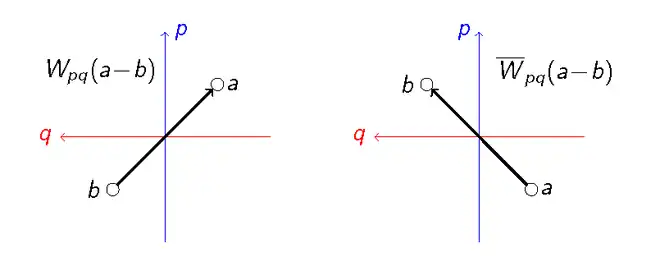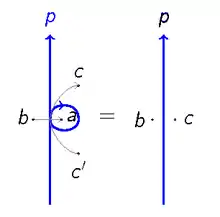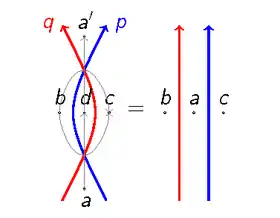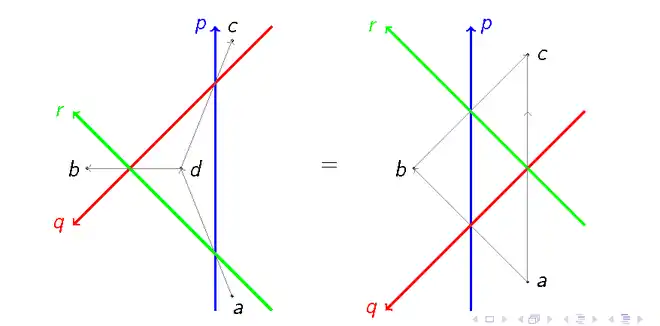Chiral Potts model
The chiral Potts model is a spin model on a planar lattice in statistical mechanics. As with the Potts model, each spin can take n=0,...N-1 values. To each pair of nearest neighbor of spins n and n', a Boltzmann weight W(n-n') (Boltzmann factor) is assigned. The model is chiral, meaning W(n-n')≠ W(n'-n). When its weights satisfy the Yang–Baxter equation, (star–triangle relation), it is integrable. For the integrable chiral Potts model, its weights are parametrized by a high genus curve, the chiral Potts curve.[1][2] Unlike the other solvable models,[3][4] whose weights are parametrized by curves of genus less or equal to one, so that they can be expressed in term of trigonometric, or rational function (genus=0) or by theta functions (genus=1), this model involves high genus theta functions, which are not yet well developed. Therefore, it was thought that no progress could be made for such a difficult problem. Yet, many breakthroughs have been made since the 1990s. It must be stressed again that the chiral Potts model was not invented because it was integrable but the integrable case was found, after it was introduced to explain experimental data. In a very profound way physics is here far ahead of mathematics. The history and its development will be presented here briefly.
Note that the chiral clock model, which has been introduced in the 1980s, independently, by David Huse and Stellan Ostlund, is not exactly solvable, in contrast to the chiral Potts model.
The model
This model is out of the class of all previously known models and raises a host of unsolved questions which are related to some of the most intractable problems of algebraic geometry which have been with us for 150 years. The chiral Potts models are used to understand the commensurate-incommensurate phase transitions.[5] For N = 3 and 4, the integrable case was discovered in 1986 in Stonybrook and published the following year.[1][6]
Self-dual case
The model is called self-dual, if the Fourier transform of the weight is equal to the weight. A special (genus 1) case had been solved in 1982 by Fateev and Zamolodchikov.[7] By removing certain restrictions of the work of Alcaraz and Santos,[8] a more general self-dual case of the integrable chiral Potts model was discovered.[1] The weight are given in product form[9][10] and the parameters in the weight are shown to be on the Fermat curve, with genus greater than 1.
Results
Order parameter
From the series[5][12] the order parameter is conjectured[13] to have the simple form
It took many years to prove this conjecture, as the usual corner transfer matrix technique could not be used, because of the higher genus curve. This conjecture was finally proven by Baxter in 2005[14][15] using functional equations and the "broken rapidity line" technique of Jimbo et al.[16] assuming two rather mild analyticity conditions of the type commonly used in the field of Yang–Baxter integrable models. Most recently, in a series of papers[17][18][19][20][21][22][23] an algebraic (Ising-like) way of obtaining order parameter has been given, giving more insight into the algebraic structure.
Connection to 6-vertex model
In 1990 Bazhanov and Stroganov[24] show that there exist an 2 × N L-operators, which satisfy the Yang–Baxter equation
where 2 × 2 R-operator is the 6-vertex R-matrix (see Vertex model). The product of four chiral Potts weight S was shown to intertwine two L-operators as
This inspired a most important breakthrough, namely the functional relations for the transfer matrices of the chiral Potts models are discovered.[25]
Free energy and interfacial tension
Using these functional relation, Baxter was able to calculate the eigenvalues of the transfer matrix of the chiral Potts model,[26] and obtained the critical exponent for the specific heat α=1-2/N, which was also conjectured in reference 12. The interfacial tensions are also calculated by him with the exponent μ=1/2+1/N.[27][28]
Relation with mathematics
Knot theory
The integrable chiral Potts weights are given in product form [2] as
where ωN=1 and we associate with each of the rapidity variable p with three variables (xp,yp,μp) satisfying
It is easy to see that
which is similar to Reidemeister move I. It was also known that the weights satisfying the inversion relation,
This is equivalent to Reidemeister move II. The star-triangle relation
is equivalent to Reidemeister move III. These are shown in the figure shown here. [29]




See also
References
- Au-Yang H., McCoy B. M., Perk J. H. H., Tang S. and Yan M-L. (1987), "Commuting transfer matrices in the chiral Potts models: Solutions of the star-triangle equations with genus > 1", Physics Letters A 123 219–23.
- Baxter R J, Perk J' H' H' and Au-Yang H (1988), "New solutions of the star-triangle relations for the chiral Potts model", Physics Letters A 128 138–42.
- R. J. Baxter,"Exactly Solved Models in Statistical Mechanics", Academic Press, ISBN 978-0-12-083180-7.
- B. M. McCoy, "Advanced Statistical Mechanics", 146 International Series of Monographs on Physics, Oxford, England, ISBN 9780199556632
- S. Howes, L.P. Kadanoff and M. den Nijs (1983), Nuclear Physics B 215, 169.
- McCoy B. M., Perk J. H. H., Tang S. and Sah C. H. (1987), "Commuting transfer matrices for the 4 state self-dual chiral Potts model with a genus 3 uniformizing Fermat curve", Physics Letters A 125, 9–14.
- V. A. Fateev and A. B. Zamolodchikov, (1982) Physics Letters A 92.
- E.C. Alcaraz and A. Lima Santos, Nuclear Physics B 275.
- H. Au-Yang, B. M. McCoy, J. H. H. Perk, and S. Tang (1988), "Solvable models in statistical mechanics and Riemann surfaces of genus greater than one", in Algebraic Analysis, Vol. 1, M. Kashiwara and T. Kawai, eds., Academic Press, pp. 29–40.
- J.H.H. Perk (1987), "Star-triangle equations, quantum Lax pairs, and higher genus curves", in Proc. 1987 Summer Research Institute on Theta Functions, Proc. Symp. Pure Math., Vol. 49, part 1 (Am. Math. Soc., Providence, R.I., 1989), pp. 341–354.
- Au-Yang H and Perk J H H (1989). "Onsager's star-triangle equation: Master key to integrability", Proc. Taniguchi Symposium, Kyoto, October 1988, Advanced Studies in Pure Mathematics vol 19 (Tokyo: Kinokuniya–Academic) pp 57–94
- M. Henkel and J. Lack, preprint Bonn-He- 85–22
- Albertini G., McCoy B. M., Perk J. H. H. and Tang S. (1989), "Excitation spectrum and order parameter for the integrable N-state chiral Potts model", Nuclear Physics B 314, 741–763
- Baxter R. J. (2005), "Derivation of the order parameter of the chiral Potts model", Physical Review Letters, 94 130602 (3 pp) arXiv:cond-mat/0501227.
- Baxter R. J. (2005), "The order parameter of the chiral Potts model", Journal of Statistical Physics 120, 1–36: arXiv:cond-mat/0501226.
- Jimbo M., Miwa T. and Nakayashiki A. (1993), "Difference equations for the correlation functions of the eight-vertex model", Journal of Physics A: Math. Gen. 26, 2199–210: arXiv:hep-th/9211066.
- Baxter R. J. (2008) "Algebraic reduction of the Ising model", Journal of Statistical Physics 132, 959–82, arXiv:0803.4036;
- Baxter R. J. (2008), "A conjecture for the superintegrable chiral Potts model", Journal of Statistical Physics 132, 983–1000, arXiv:0803.4037;
- Baxter R J (2009), "Some remarks on a generalization of the superintegrable chiral Potts model", Journal of Statistical Physics 137, 798–813, arXiv:0906.3551;
- Baxter R. J. (2010), "Spontaneous magnetization of the superintegrable chiral Potts model: calculation of the determinant DPQ", Journal of Physics A 43, 145002 (16pp) arXiv:0912.4549.
- Baxter R. J. (2010), "Proof of the determinantal form of the spontaneous magnetization of the superintegrable chiral Potts model", Australian & New Zealand Industrial and Applied Mathematics Journal, 51 arXiv:1001.0281.
- Iorgov N., Pakuliak S., Shadura V., Tykhyy Yu and von Gehlen G. (2009), "Spin operator matrix elements in the superintegrable chiral Potts quantum chain", Journal of Statistical Physics 139, 743–68 arXiv:0912.5027.
- Au-Yang H and Perk J. H. H. (2011), "Spontaneous magnetization of the integrable chiral Potts model", Journal of Physics A 44, 445005 (20pp), arXiv:1003.4805.
- V. V. Bazhanov and Yu. G. Stroganov (1990), "Chiral Potts model as a descendant of the six-vertex model", Journal of Statistical Physics 59, pp 799–817.
- Baxter R. J., Bazhanov V. V. and Perk J. H. H. (1990), "Functional relations for transfer matrices of the chiral Potts model", International Journal of Modern Physics B 4, 803–70.
- Baxter R J (1991), "Calculation of the eigenvalues of the transfer matrix of the chiral Potts model", Proceeding of Fourth Asia Pacific Physics Conference (Singapore: World Scientific) pp 42–58.
- Baxter R. J. (1993), "Chiral Potts model with skewed boundary conditions", Journal of Statistical Physics 73, 461–95.
- Baxter R. J. (1994), "Interfacial tension of the chiral Potts model", Journal of Physics A 27, pp 1837–49.
- Au-Yang Helen, Perk H. H. Jacques (2016), arXiv:1601.01014